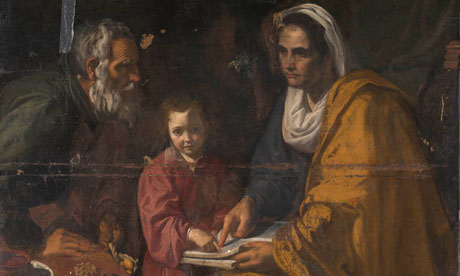Wednesday, July 21st, 2010
A Little Skepticism over Discoveries
My friends, we either live in a very fruitful time for artistic discoveries, or something is out-of-whack. Has anyone paid attention to how many works of art that have been recently discovered? Just within this past year, there have been several works of art (or art-related discoveries, like Caravaggio’s bones) that have been brought to public attention. I’m sure that I haven’t posted about all of the discoveries made within these past few months, but here are a couple that I pulled out of my archives (noted with their post date, not the discovery date):
October 2009: “La Bella Principessa” attributed to Leonardo (via fingerprinting)
November 2009: Raphael Copy Discovered in Apartment
January 2010: Rembrandt Discovered in Bathroom Cabinet
May 2010: Possible Raphael Found in Modena
June 2010: Caravaggio Bones Discovered

And now, just as of this month, there are two more possible discoveries to include in the list. The Vatican recently reported
the possible discovery of a new Caravaggio painting, the
Martyrdom of St. Lawrence (see right). I have to admit, I’m quite skeptical about this new “discovery.” Although I haven’t seen the painting in person, some of the things look a little “off” to me. I think the treatment of the blue drapery is a little unrefined, as well as the rendering of Lawrence’s left arm and right hand. But who knows? I could be wrong. I’m a historian, not a connoisseur. Maybe I’m just skeptical as to why the Vatican is announcing this timely “discovery” during the celebrations marking the 400th anniversary of Caravaggio’s death. It seems a little too convenient, and I wonder if people are getting too hyped-up over Caravaggio to think sensibly.

The other work of art recently “discovered” was found in the basement of Yale University Art Gallery (see left). The
Guardian reports that this battered canvas, which was located in the museum basement, has now been attributed to Velasquez. The Prado Museum is reserving judgment on the painting, and I’m tending to do the same. When I read that this painting was discovered in the museum basement, I sarcastically thought, “
Of course. Of course it was discovered in the basement.” Maybe I’m too skeptical, but it seems like all museum directors would be interested in rummaging through their basement storage right now, ever since a possible Raphael was discovered in storage this past May.
What do other people think? Are you beginning to get skeptical of these discoveries? Or are you happy to embrace discoveries with open arms? I sure like the idea of paintings being discovered, but starting to get a little wary…

You, wary? Say it ain't so!
I was/am pretty skeptical about the Leonardo discovery. It's all just soooo convenient. I don't really know enough about any of the other discoveries to judge, but a work by a famous artist certainly makes more of a splash (and fetches bigger prices) than one by someone only art historians would know. So no one's working without some self-interest in these cases.
Hey, maybe that could be the plot for a new Dan Brown novel! A secret society is planting Old Master paintings all over the globe in a conspiracy to inflate market values so they can buy off the Vatican's art collection when the market inevitably falls. Mwahahahahaha! 😉
@heidenkind : there's more to the Leonardo attribution that a single fingerprint fragment, as intriguing as that is.
I'm hosting an oxford uni podcast Professor Kemp did on the attribution , it's the most info you'll get without buying the book. You can listen to it here:
http://threepipeproblem.blogspot.com/2010/06/professor-martin-kemp-on-leonardo-and.html
As for the discoveries, I don't think anything is out of whack more than usual. We just hear about things more frequently because of the truly global nature of the internet and news services.
As more historians and the like pour through inventories and documents, new things are going to come up.
A great example is the Medici Archive Project, considering the amazing number of documentation that remains unexamined, one can only imagine the amazing facts and discoveries that remain to be revealed.
More info on that at http://www.medici.org
I'm glad that hard Science is playing a stronger role in verifying paintings rather than the opinions of invariably biased connoisseurs.
I experienced a perfect example of a connoisseur getting something spectacularly wrong – identifying a plant in a Botticelli based on guesswork and misinformation, whereas a scientist was able to demonstrate through genetic studies and archaeo-botanical evidence that this plant was nowhere near Italy in Botticelli's time.
One day, we can only hope that Art History students will also be trained in the Scientific Method, and the speculation that governed conoisseurship will be a thing of the past.
My health stats professor famously said, "Data gaps=Danger"
I find it dismaying that multi million dollar attributions are often made based on conoisseurship alone.
Luckily we can't proceed like this in the Health Sciences research – where data gaps can have more dire consequences than a wonky valuation, or an error in a textbook!
Kind Regards
H
heidenkind: Ha ha! I think you should pitch that idea to Dan Brown. 🙂
H Niyazi: You bring up a good point about how there is more access to news information today. You definitely are right – we do hear about discoveries more frequently for that reason. I also like that science is playing a larger role in attributing works to certain artists. Connoisseurship is such a subjective discipline; it's nice to see that other scientific methods are gaining popularity for the attribution process.